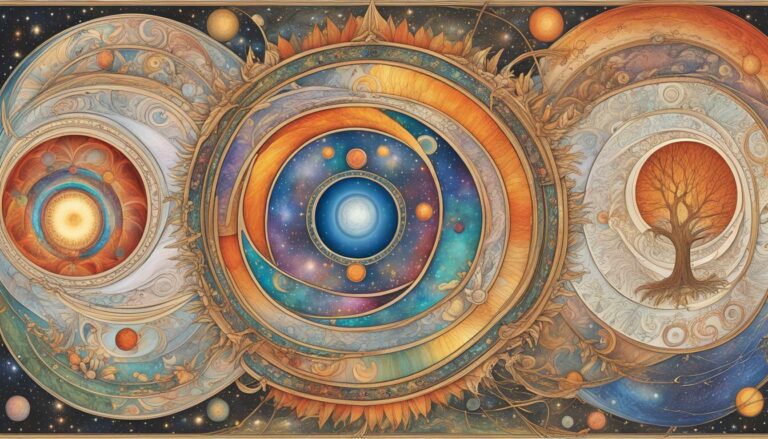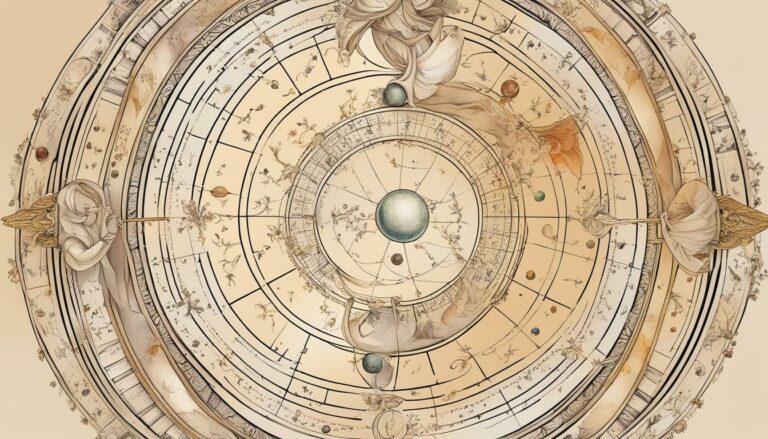Discovering the Inconjunct: What is Inconjunct in Astrology?
Are you familiar with the inconjunct aspect in astrology? This unique aspect is often overlooked but holds significant importance in understanding the intricate connections between different areas of your life.
An inconjunct occurs when two planets are 150 degrees apart, creating a challenging angle that represents a disconnect between two areas of your life. As a result, the inconjunct aspect is often associated with tension, imbalance, and frustration.
However, it’s important to note that the inconjunct also presents an opportunity for growth and learning. By understanding the meaning and significance of the inconjunct in your astrological profile, you can gain valuable insights into navigating the complex web of cosmic influences shaping your path.
Key Takeaways:
- The inconjunct is an aspect in astrology that occurs when two planets are 150 degrees apart.
- It represents a disconnect between two areas of your life and is typically associated with tension and imbalance.
- However, the inconjunct also presents an opportunity for growth and learning.
- Understanding the inconjunct in your astrological profile can provide valuable insights into navigating the complex web of cosmic influences shaping your path.
Understanding the Inconjunct Aspect
In astrology, the inconjunct aspect is represented by two planets positioned 150 degrees apart from each other, creating an angle that is not harmonious nor challenging. Instead, the inconjunct aspect signifies a subtle, yet persistent, disconnect between the energies of these two planets in your natal chart.
The inconjunct aspect represents areas of your life that require adjustment and integration. It often manifests as a feeling of dissonance or frustration, as if you are dealing with two conflicting qualities or desires that refuse to align.
Interpreting the inconjunct aspect in your natal chart can be challenging, as its effects are subtle and nuanced. However, analyzing this aspect can provide valuable insights into the areas of your life that require attention and growth.
Interpreting Inconjunct in Natal Chart
When examining the inconjunct in your natal chart, its interpretation depends on the planets involved. For example, an inconjunct between the Moon and Mercury can signify difficulties in expressing emotions, while an inconjunct between Mars and Venus can indicate challenges in balancing passion with affection.
Interpreting the inconjunct aspect involves understanding the qualities of the planets involved, their position in your natal chart, and the houses they rule. You may need to examine other aspects in your chart to gain a clearer understanding of the inconjunct’s influence.
An important aspect to consider when interpreting the inconjunct in your natal chart is the orb, which is the maximum distance between the two planets that are still considered to be in aspect. A tighter orb indicates a stronger and more noticeable impact of the inconjunct aspect on your personality and life.
How to Interpret Inconjunct Aspects
Interpreting the inconjunct aspect involves identifying the areas of your life that require adjustment and integration. It requires a willingness to confront your shortcomings and acknowledge your strengths to find balance.
To interpret the inconjunct aspect in your chart, you can start by examining the qualities and energies of the planets involved, and then explore how these energies interact with other planets and houses in your chart. You may also want to seek the guidance of a professional astrologer to gain a deeper understanding of the inconjunct’s influence on your life.
In summary, understanding the inconjunct aspect in your natal chart can provide valuable insights into the areas of your life that require adjustment and growth. By analyzing this aspect and working towards balance, you can unlock your full potential and navigate your life’s challenges with greater ease.
Exploring the Inconjunct in Synastry
When it comes to relationships, the inconjunct astrology aspect is a significant factor to consider. This aspect is formed when two planets are approximately 150 degrees apart, creating an angle that is neither harmonious nor challenging. Instead, it represents a sense of discomfort and unease, which can manifest in various ways in different areas of life, including relationships.
In synastry, which is the study of how two individuals interact and relate to each other in a relationship, the inconjunct aspect can indicate a lack of understanding between partners. This can result in tension and conflict arising from different perspectives, values, and communication styles. However, the inconjunct aspect can also bring complementary qualities to a relationship, allowing partners to learn from each other’s strengths and weaknesses.
For example, if one partner has an inconjunct between their Venus and the other partner’s Mars, they may have different approaches to love and passion. While Venus represents love, beauty, and harmony, Mars symbolizes passion, sexuality, and drive. The inconjunct aspect between these two planets can create tension and disagreement between partners. However, if both partners are willing to understand and respect each other’s perspectives, they can learn how to balance their strengths and weaknesses to bring harmony and passion to their relationship.
It is essential to note that the influence of the inconjunct aspect in synastry depends on various factors, such as the specific planets involved, the signs and houses they are in, and the orb of the aspect. Therefore, it is crucial to interpret this aspect in the context of the overall astrological chart and the individual’s personality traits and life experiences.
In conclusion, understanding the inconjunct aspect in synastry provides valuable insights into the dynamics of relationships. While this aspect can create tension and discomfort, it can also bring complementary qualities and opportunities for growth and learning. By interpreting the inconjunct aspect in the context of the individual’s natal chart and relationship dynamics, you can gain a deeper understanding of the cosmic influences shaping your path.
The Influence of Inconjuncts in Natal Charts
Inconjuncts in natal charts have a significant impact on your personality traits, challenges, and opportunities. This aspect is formed between two planets that are 150 degrees apart, creating a tense and uncomfortable energy that often leads to frustration and conflict.
When you have an inconjunct in your natal chart, it means that two planets are in signs that have very different energies and do not communicate well with each other. This creates an internal conflict within yourself, as you struggle to balance the energies of these planets.
The orb in inconjunct aspects is significant, as a wider orb means that the aspect is weaker, and a tighter orb means that the aspect is stronger. A tight orb highlights the internal conflict and tension created by inconjuncts, while a wider orb indicates that the energies of the two planets are less conflicting.
Interpreting inconjuncts in your natal chart requires a deep understanding of the energies of the planets involved, as well as their placement in specific signs and houses. The placement of the inconjunct in your chart can also provide insight into which areas of your life are most affected by this aspect.
Inconjuncts can present significant challenges, but they also provide opportunities for growth and self-awareness. By understanding the conflicting energies in your natal chart, you can identify areas of your life where you may experience internal conflict and work towards finding balance and resolution.
Interpreting Inconjunct Aspects
Interpreting inconjunct aspects in astrology requires a nuanced understanding of the complex interplay of planetary energies. These aspects are characterized by a 150-degree angle between two celestial bodies, indicating a fundamental tension and lack of rapport between them.
When interpreting inconjunct aspects in your natal chart, it is essential to examine the planets involved, their zodiac signs, and the houses they occupy. The specific nature of the planets and signs can shed light on the areas of life where you are likely to experience challenges and growth opportunities.
For example, an inconjunct between Mercury in Aries and Jupiter in Scorpio could indicate difficulties in finding a balance between your assertive communication style and the need for deep introspection and transformation. You may struggle with expressing your ideas effectively, leading to misunderstandings or conflicts in your personal or professional relationships.
Another crucial factor to consider when interpreting inconjunct aspects is the orb, which refers to the distance between the two planets involved. Generally, the tighter the orb, the more potent the influence of the inconjunct aspect. An orb of 1-2 degrees is considered significant, while an orb of 3-4 degrees may have a weaker impact.
It is also important to analyze the ruling planets of the inconjunct signs and houses to gain a deeper understanding of the energy at play. For instance, if the inconjunct involves the 1st and 7th houses, which represent the self and relationships, respectively, examining the ruling planets of Aries and Libra can provide insights into how to balance the conflicting energies.
When learning how to interpret inconjunct aspects, it can be helpful to consult with an experienced astrologer or reference materials to develop your skills confidently. With practice, you can unlock valuable guidance on how to navigate the challenges and opportunities presented by these complex and often misunderstood aspects.
Unveiling the Cosmic Links Through Inconjunct
The inconjunct aspect in astrology is more than just a challenging aspect to deal with. It has a deeper spiritual significance that can connect different parts of your life and guide you in your soul’s journey. The inconjunct aspect is like a puzzle piece that fits into the bigger picture of your life and helps you understand your purpose and destiny.
What is inconjunct in astrology? Inconjunct, also known as quincunx in traditional astrology, is an aspect that occurs between planets that are 150 degrees apart. This aspect creates a tension or discomfort that requires adjustment and adaptation to resolve.
But beyond its disruptive effects, the inconjunct aspect can reveal the hidden links between seemingly unrelated areas of your life. It can show you how your past experiences, present challenges, and future aspirations are intertwined and interdependent.
By understanding the inconjunct aspect meaning, you can gain insight into how your inner conflicts and external circumstances are part of a larger cosmic plan. You can use this knowledge to make wiser decisions, align your actions with your values, and overcome obstacles that stand in the way of your growth.
Unleashing the Spiritual Potential of Inconjunct
One way to interpret the inconjunct aspect is to see it as a call to awaken your spiritual potential. The inconjunct aspect can represent the gap between your human self and your divine self, the area where you struggle to integrate your material and spiritual needs.
Through the inconjunct aspect, you can harness the power of paradox and ambiguity and tap into a higher consciousness that transcends duality. The inconjunct aspect can encourage you to embrace your unique path and find meaning and purpose in your struggles and challenges.
You can use meditation, journaling, or counseling to explore the deeper layers of your inconjunct aspects and uncover the cosmic links that connect them. By doing so, you can release the limiting beliefs that hold you back and unleash your spiritual potential.
Embracing the Gifts and Lessons of Inconjunct
The inconjunct aspect can be challenging, but it also carries gifts and lessons that can help you grow and evolve. For example, the inconjunct aspect can teach you how to adapt to change, cultivate flexibility, and find creative solutions to complex problems.
Moreover, the inconjunct aspect can reveal your hidden talents, strengths, and passions that lie dormant or undiscovered. By embracing these gifts, you can express yourself authentically and fulfill your life purpose.
When interpreting inconjunct aspects, it’s essential to focus on their positive aspects as well as their negative ones. By doing so, you can avoid succumbing to victimhood or self-pity and instead see the bigger picture of your life.
Conclusion
The inconjunct aspect in astrology is a complex and multi-faceted aspect that requires careful interpretation. By understanding the inconjunct aspect meaning and embracing its spiritual potential, you can unlock valuable insights into your life purpose and navigate your soul’s journey with greater clarity and wisdom.
Conclusion
Understanding the inconjunct aspect in astrology is a powerful tool for gaining insight into the complex connections between different areas of your life. By learning to interpret this aspect in your natal chart, you can unlock valuable guidance and better navigate the cosmic influences shaping your path.
Whether you’re trying to understand the challenges and opportunities presented by the inconjuncts in your chart, or looking to explore the deeper cosmic links revealed through this aspect, taking the time to study the inconjunct in astrology can help you to better understand yourself and the world around you.
Explore Further
If you’re interested in diving deeper into the study of astrology and the inconjunct aspect, there are a wealth of resources available to help you on your journey. From books and articles to online courses and workshops, there are many ways to continue exploring this fascinating subject.
So why not start exploring today? With a solid understanding of the inconjunct in astrology, you can pave the way for a more fulfilling and spiritually rewarding life. And who knows – you might just discover something new and exciting about yourself in the process!
FAQ
Q: What is an inconjunct in astrology?
A: An inconjunct, also known as a quincunx, is an aspect in astrology that occurs between two planets that are approximately 150 degrees apart. It represents a challenging and uneasy relationship between the energies of the planets involved.
Q: What is the significance of the inconjunct aspect in astrology?
A: The inconjunct aspect signifies a need for adjustment and integration between the energies represented by the planets involved. It brings tension and requires conscious effort to find a harmonious balance between these energies.
Q: How does the inconjunct aspect influence my natal chart and life?
A: The inconjunct aspect in your natal chart indicates areas of your life where you may experience internal conflicts or difficulties finding balance. It highlights areas that require conscious awareness and effort for personal growth and integration.
Q: How can I interpret inconjunct aspects in my natal chart?
A: Interpreting inconjunct aspects involves understanding the energies of the planets involved and recognizing the need to integrate them in a harmonious way. It requires analyzing the specific houses and signs involved to gain insights into the challenges and opportunities presented by these aspects.
Q: How does the inconjunct aspect influence relationships in synastry?
A: In synastry, the inconjunct aspect suggests areas of tension and adjustment between individuals. It may indicate challenges in communication and understanding, requiring conscious effort to find resolution and harmony in the relationship.
Q: What is the orb significance in inconjunct aspects?
A: The orb represents the allowable range of degrees between two planets for an aspect to be considered valid. In the case of inconjunct aspects, a smaller orb is typically used to emphasize the precise and challenging nature of this aspect.
Q: How does the inconjunct aspect connect different aspects of my life?
A: The inconjunct aspect acts as a bridge between different areas of your life, highlighting the need for integration and balance. It reveals how the energies represented by the planets involved relate to each other and impact various aspects of your life journey.






